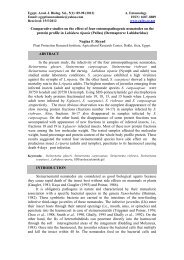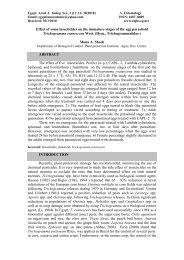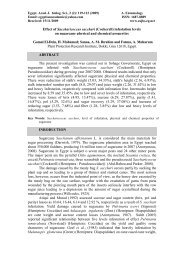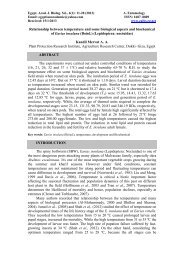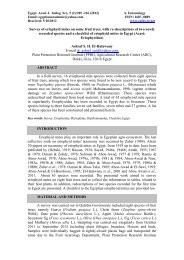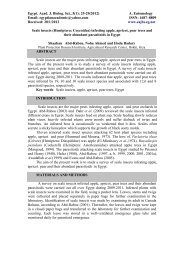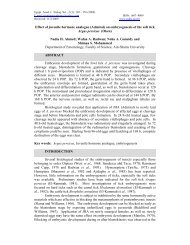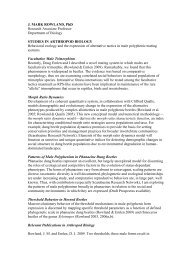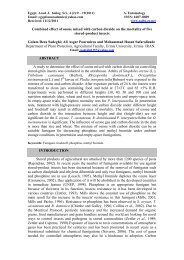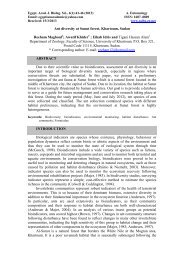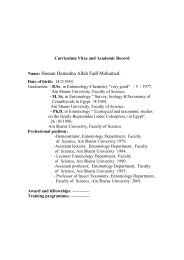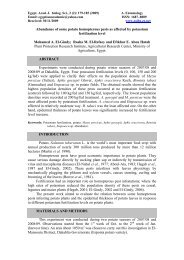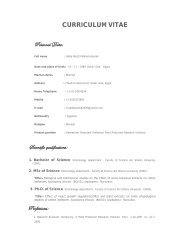Heat Requirements for the Development of the Black cutworm ...
Heat Requirements for the Development of the Black cutworm ...
Heat Requirements for the Development of the Black cutworm ...
Create successful ePaper yourself
Turn your PDF publications into a flip-book with our unique Google optimized e-Paper software.
<strong>Heat</strong> <strong>Requirements</strong> <strong>for</strong> <strong>the</strong> <strong>Development</strong> <strong>of</strong> <strong>the</strong> <strong>Black</strong> <strong>cutworm</strong>, Agrotis ipsilon 119<br />
temperature increased. The means <strong>of</strong> incubation periods were 6.18, 3.67 and 2.81<br />
days at 20, 25 and 302C, respectively. Statistically, <strong>the</strong>re are obvious significant<br />
differences in A. ipsilon incubation period at all <strong>the</strong> tested constant temperatures.<br />
Table (1): <strong>Development</strong> <strong>of</strong> A. ipsilon eggs under different constant temperatures and its <strong>the</strong>rmal requirements.<br />
Temp.<br />
( °C)<br />
Incubation<br />
period<br />
(days ± S.E) Expect<br />
duration (days)<br />
Rate <strong>of</strong><br />
development<br />
%<br />
Expect rate <strong>of</strong><br />
development<br />
%<br />
20 6.18 ± 0.04 a 6.02 16.18 16.61<br />
to<br />
(˚C)<br />
Degree days<br />
(dd΄s)<br />
25 3.67 ± 0.18 b 3.79 27.24 26.37 11.49 49.6<br />
30 2.81 ± 0.02 c 2.77 35.71 36.14 51.8<br />
Average 51.3<br />
L.S.D 0.16<br />
The threshold <strong>of</strong> egg development was calculated and illustrated in Fig. (1);<br />
it was found to be 11.49C. The average <strong>of</strong> <strong>the</strong>rmal units in degree – days required<br />
<strong>for</strong> <strong>the</strong> completion <strong>of</strong> development <strong>of</strong> this stage was 51.3 dd's. The three observed<br />
values <strong>of</strong> eggs rate <strong>of</strong> development at <strong>the</strong> constant temperature range (20 - 30C)<br />
gave a remarkable good fit to <strong>the</strong> calculated temperature – velocity line having <strong>the</strong><br />
<strong>for</strong>mula Y = 1.95 x - 22.4 (Fig. 1).<br />
R a t e o f d e v(1/t e l ox1 p0 ) m0 e n t<br />
4 0<br />
3 5<br />
3 0<br />
2 5<br />
2 0<br />
1 5<br />
1 0<br />
5<br />
0<br />
r = 0 . 9 9 K = 5 1 . 3<br />
y = 1 . 9 x5 - 2 2 . 4<br />
0 5 1 0 1 5 2 0 2 5 3 0<br />
T e m p e r a t u r e ( ° C)<br />
F i g . ( 1 ) : T h e r e g r e s s i o n l i n e o f t h e r e l a t i o n b e t w e e n t h e<br />
r a t e o f d e v e l o p m e n t o f A . i p s i l o n e g g s a n d d i f f e r e n t<br />
Fig. (1): The regression line <strong>of</strong> <strong>the</strong> relation c o nbetween s t a n t t e m<strong>the</strong> p e rate r a t u r<strong>of</strong> e s development .<br />
<strong>of</strong> A. ipsilon eggs and<br />
different constant temperatures.<br />
Larval stage:<br />
Table (2) indicated that <strong>the</strong> average larval duration varied from 33.06 days<br />
at 20C to 15.81 days at 30C. The analysis <strong>of</strong> variance showed significant<br />
differences (P < 0.01) between <strong>the</strong> means <strong>of</strong> larval duration at all tested<br />
temperatures. The lower threshold <strong>of</strong> development (t 0) <strong>for</strong> <strong>the</strong> larval stage was<br />
10.63C as indicated in Fig. (2).<br />
The same Table showed that <strong>the</strong> average <strong>the</strong>rmal units required <strong>for</strong> larval<br />
developmental till pupation was 303.5 dd's as determined by <strong>the</strong> <strong>the</strong>rmal<br />
summation equation.<br />
52.6



